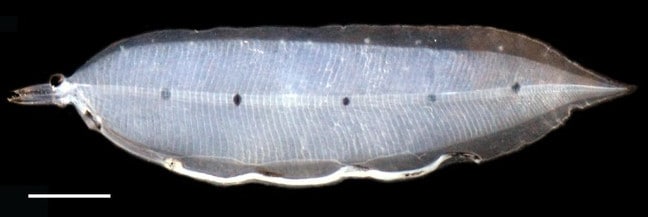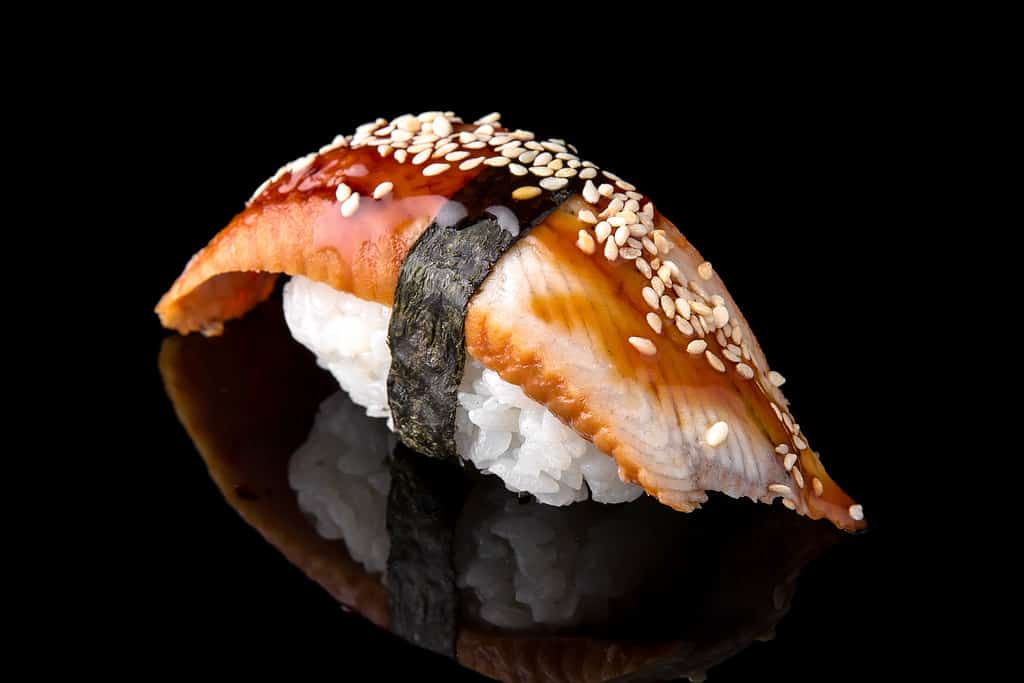Ever been scuba diving and seen what looked like a plastic bag floating in front of you? If it was moving and twisting, looking similar to a snake, you likely saw a leptocephalus. They are almost completely transparent, with tiny heads and long bodies.
The name leptocephalus means “tiny head,” which is an accurate description of the species. They are see-through because they have a very small amount of muscle and a body made of a jelly-like mucous substance. In addition, they have extremely small organs and a simple tube for their gut. All of these biological adaptations make it so that the species appears almost fully translucent in the water. They primarily live in the first three to four-hundred feet of the ocean, going deeper during the daytime and returning to more shallow waters at night.
Leptocephali are not of a specific species and are actually the larva stage of eels, marine eels, and other species of the order Elopomorpha. They do not stay in this stage for an extended period because they are only the third stage in an eel’s lifecycle. They do not have any red blood cells until they reach the juvenile stage, the next stage in their lives. Juvenile eels actually begin to look like eels rather than transparent leptocephalus.
Leptocephalus larvae are around thirteen inches long and three inches wide. They are also noted for having fang-like teeth that are lost in the next stage of their lives.

©Jan Y. Poulsen, Michael J. Miller, Tetsuya Sado, Reinhold Hanel, Katsumi Tsukamoto, Masaki Miya, CC BY 4.0 <https://ift.tt/gfiywjr>, via Wikimedia Commons – License
Life as a Leptocephalus
The lifecycle of an eel begins with eggs. These eggs are large compared to many other species of fish. When the eggs hatch, the stage of the emerging species is called preleptocephalus. This is just before the leptocephalus stage in life, and at this time, the young eels don’t yet eat externally. This likely has something to do with their poor eyesight and a minimal amount of teeth. In this developing stage, the preleptocephali hatch at different levels of development. Some have fully formed heads, and others hatch and are much less developed.
In this early stage of life, the preleptocephali won’t do very much, not eating and socializing. They won’t leave their eggs until they consume the yolk sack they were hatched in. After the yolk sack is consumed and their faces have fully developed, they enter into the leptocephalus stage of life. It’s at this time that their teeth become sharper and forward-facing. These teeth don’t stay for a long time, though, eventually falling out and becoming shorter and more in number.
The next stage in an eel’s life is the glass, or juvenile, eel stage. This stage is reached once the leptocephali grow to their largest size. During this stage, their bodies begin to expand from their compressed state and grow rounder. They become less translucent and sometimes turn a gray color. At this time, while their bodies and heads thicken, they lose all of their teeth. It is at this time they enter the adult stage in the lifecycle of an eel.

©Gerald Robert Fischer/Shutterstock.com
Feeding on Marine Snow
Leptocephali are a peculiar species because they are different from the larva of most eel and fish species. Most larvae consume their yolk sack after hatching like leptocephalus, but they don’t begin feeding externally until the next stage in their lives. They are also very fragile, which is clear from their physical appearance.
Leptocephali feed externally on particulate matter. This means that they eat the small pieces of matter that exist in the water, but they don’t eat zooplankton. This tiny particulate matter is called “marine snow,” often referred to as “ocean dandruff.” While that certainly doesn’t sound appetizing, leptocephali seem to like it quite a lot. The marine snow is made up of organic matter, including dead and dying animals, phytoplankton, and fecal matter.
Leptocephalus in the Modern World
Leptocephali are being grown in laboratories, particularly in Asia. This is because the Japanese eel is a delicacy in many countries, and the leptocephalus is part of the eel’s first life stages. The dish, called unagi, is usually served warm, sliced, on a bed of white rice. Scientists are currently attempting to recreate leptocephali through artificial spawning. Since these eel larvae are such a strange species, scientists are having trouble reproducing them artificially. This is mostly due to their inability to recreate the marine snow that leptocephali feed on.
Leptocephalus is not part of any common dishes, but they are eaten in this stage of life in a few places. The leptocephalus of the Japanese conger eel is the type that is specifically used in meals. They are called noresore and are most commonly served raw. Some restaurants also serve the leptocephalus with a vinegar-based sauce. This dish is most commonly served during the springtime as a seasonal special. They are a rare delicacy that is enjoyed most in parts of Japan and East Asia.

©MaryLucky/Shutterstock.com
The post Meet the Rare Invisible Fish That Looks Like an Eel appeared first on AZ Animals.
from Animal News, Facts, Rankings, and More! - AZ Animals https://ift.tt/nI1bfmX